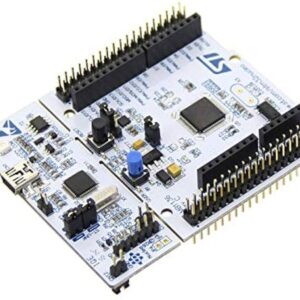Description
Features:
- STM32F407VGT6 micro-controller featuring 32-bit ARM® Cortex® -M4 with FPU core, 1-Mbyte Flash memory, 192-Kbyte RAM in an LQFP100 package
- On-board ST-LINK/V2 on STM32F4DISCOVERY (old reference) or ST-LINK/V2-A on STM32F407G-DISC1 (new order code)
- USB ST-LINK with re-enumeration capability and three different interfaces:
- Debug port
- Virtual Com port (with new order code only)
- Mass storage (with new order code only)
- Board power supply: through USB bus or from an external 5 V supply voltage
- External application power supply: 3 V and 5 V
- LIS302DL or LIS3DSH ST MEMS 3-axis accelerometer
- MP45DT02 ST-MEMS audio sensor omnidirectional digital microphone
- CS43L22 audio DAC with integrated class D speaker driver
- LD1 (red/green) for USB communication
- LD2 (red) for 3.3 V power on
- Four user LEDs, LD3 (orange), LD4 (green), LD5 (red) and LD6 (blue)
- 2 USB OTG LEDs LD7 (green) VBUS and LD8 (red) over-current
- Two push-buttons (user and reset)
- USB OTG FS with micro-AB connector
- Extension header for all LQFP100 I/Os for quick connection to prototyping board and easy probing
- Comprehensive free software including a variety of examples, part of STM32CubeF4 package or STSW-STM32068 to use legacy standard libraries.
Micro controller:
Soldered on the board is an STM32F407VG micro-controller packaged in a 100-pin LQFP (Low-profile Quad Flat Pack). This micro-controller contains an ARM Cortex-M4 core with FPU (Floating Point Unit).
Some of the features of the STM32F407VG micro-controller are:
- 1M Byte Flash memory
- 192k Bytes RAM
- On-chip RC oscillator
- Powered by a single supply of 1.8V to 3.6V
- Up to 168MHz operation
- I/O pins multiplexed with many internal peripherals
- USB OTG HS/FS
- Ethernet
- Static memory controller supporting Compact Flash, SRAM, PSRAM, NOR and NAND memories
- LCD parallel interface
- This microcontroller is part of the STM32F4 Hi-performance and DSP series of Cortex-M4s from ST.
Board Features
ST-LINK
The ST-LINK is an ST Microelectronics USB JTAG tool for programming and debugging STM8 and STM32 microcontrollers. It is an external tool that is used to program and debug STM microcontrollers using JTAG or SWD (Serial Wire Debug).
An embedded ST-LINK is included on the STM32F4-Discovery evaluation board that can be used to program the onboard STM32F407VG microcontroller. The embedded ST-LINK can also be used to single-step through the source code and debug the target microcontroller.
By removing two jumper links on the board, the embedded ST-LINK can be used as a programmer/debugger to program/debug an ST microcontroller on another board via a cable from the SWD connector. The embedded ST-LINK is limited to programming STM32F microcontrollers via an SWD link only. JTAG is not supported by the embedded ST-LINK.
Peripherals and Headers:
I/O Interface Devices
The board features four user programmable LEDs and a user programmable push-button switch. A second push-button is connected to the reset pin (NRST) of the microcontroller.
Audio
The STM32F407VG is also interfaced to an Audio DAC and MEMS microphone. A stereo audio jack is on board for connecting headphones or speakers to the audio output of the DAC.
USB
The board has one USB OTG full speed port available on a USB micro-B connector.
Motion Sensor
A three-axis linear accelerometer is interfaced to the board.
Headers
All of the I/O pins of the STM32F407VG are available on pin headers. Two 25 by 2 (50 pin) headers are located on either side of the board along its length, one per side. The pin names are silk-screened next to the pin headers. The pin headers protrude from the top of the board allowing easy attachment of oscilloscope or logic analyzer test probes.
Oscillators:
Although the STM32F407VG has two internal RC oscillators, an 8MHz crystal is used for the main oscillator. There is place on the board for a 32.768kHz crystal which is not fitted.
Solder Bridges:
The board has a number of solder-bridge connectors that can be soldered closed or de-soldered to open them in order to make or break connections.
Current Consumption
A jumper link on the board can be removed allowing an ammeter to be connected if current consumption of the microcontroller needs to be measured.







Reviews
There are no reviews yet.